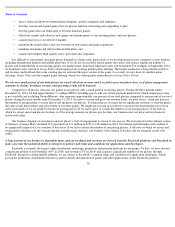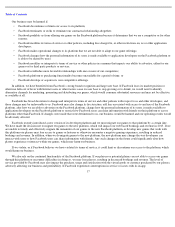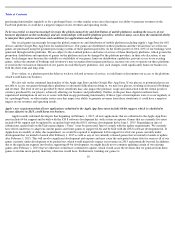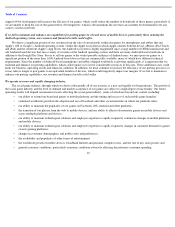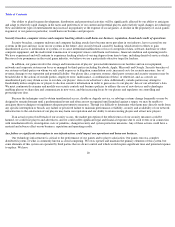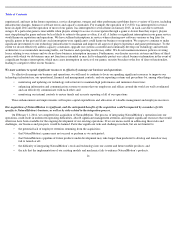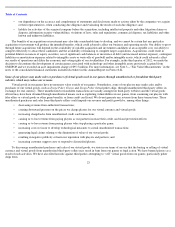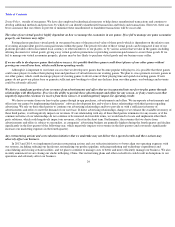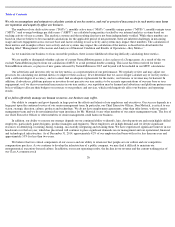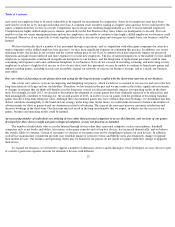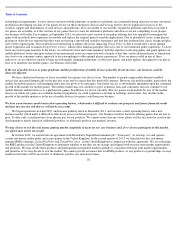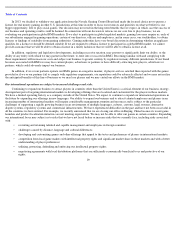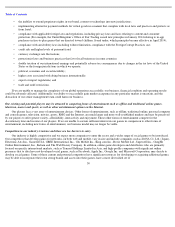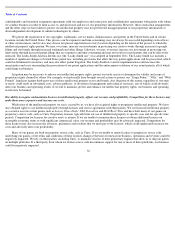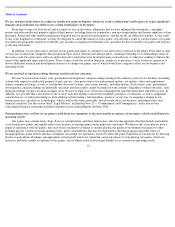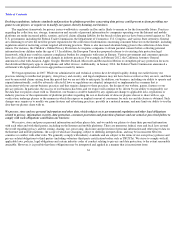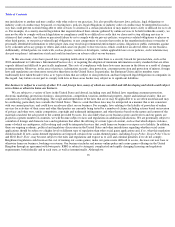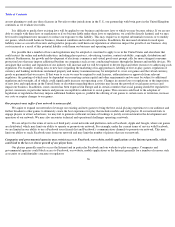Zynga 2014 Annual Report Download - page 29
Download and view the complete annual report
Please find page 29 of the 2014 Zynga annual report below. You can navigate through the pages in the report by either clicking on the pages listed below, or by using the keyword search tool below to find specific information within the annual report.
Table of Contents
We rely on assumptions and estimates to calculate certain of our key metrics, and real or perceived inaccuracies in such metrics may harm
our reputation and negatively affect our business.
The numbers of our daily active users (“DAUs”), monthly active users (“MAUs”) monthly unique payers (“MUPs”),
monthly unique users
(“MUUs”) and average bookings per daily users (“ABPU”) are calculated using metrics tracked by our internal analytics systems based on
tracking activity of user accounts. The analytics systems and the resulting data have not been independently verified. While these numbers are
based on what we believe to be reasonable calculations for the applicable period of measurement, there are inherent challenges in measuring
usage and user engagement across our user base and factors relating to user activity and systems may impact these numbers. The calculation of
these metrics and examples of how user activity and our systems may impact the calculation of the metrics is described in detail under the
heading titled “Management’s Discussion and Analysis of Financial Condition and Results of Operations—Key Metrics.”
As we transition our business to focus on mobile products, there is more likelihood of having difficulty calculating these metrics.
We are unable to distinguish whether a player of current NaturalMotion games is also a player of a Zynga game. As a result of this we
exclude NaturalMotion players from our calculation of MUU to avoid potential double counting. This issue has been resolved for future
NaturalMotion releases, so players of new games released by NaturalMotion in 2015 and beyond will be included in our MUU calculations.
Our advertisers and investors rely on our key metrics as a representation of our performance. We regularly review and may adjust our
processes for calculating our internal metrics to improve their accuracy. If we determine that we can no longer calculate any of our key metrics
with a sufficient degree of accuracy, and we cannot find an adequate replacement for the metric, our business or revenue may be harmed. In
addition, if advertisers, platform partners or investors do not perceive our user metrics to be accurate representations of our user base or user
engagement, or if we discover material inaccuracies in our user metrics, our reputation may be harmed and advertisers and platform partners may
be less willing to allocate their budgets or resources to our products and services, which could negatively affect our business and operating
results.
If we fail to effectively manage our human resources, our business may suffer.
Our ability to compete and grow depends in large part on the efforts and talents of our employees and executives. Our success depends in a
large part upon the continued service of our senior management team. In particular, our Chief Executive Officer, Don Mattrick, is critical to our
vision, strategic direction, culture, products and technology. We do not have employment agreements, other than offer letters, with our senior
management team and we do not maintain key-
man insurance for Mr. Mattrick or any other member of our senior management team. The loss of
our Chief Executive Officer or other members of senior management could harm our business.
In addition, our ability to execute our strategy depends on our continued ability to identify, hire, develop motivate and retain highly skilled
employees, particularly game designers, product managers and engineers. These employees are in high demand, and we devote significant
resources to identifying, recruiting, hiring, training, successfully integrating and retaining them. We have experienced significant turnover in our
headcount over the last year, which has placed and will continue to place significant demands on our management and our operational, financial
and technological infrastructure. As of December 31, 2014, approximately 42% of our employees had been with us for less than one year and
approximately 55% for less than two years.
We believe that two critical components of our success and our ability to retain our best people are our culture and our competitive
compensation practices. As we continue to develop the infrastructure of a public company, we may find it difficult to maintain our
entrepreneurial, execution-focused culture. In addition, our recent operating results, the decline in our revenue and the current trading price of
our Class A common stock
26


